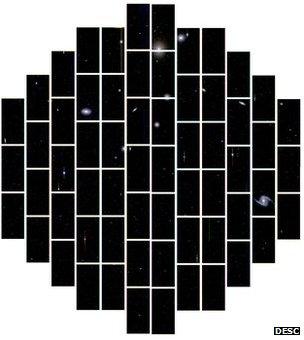Dark energy camera snaps first images ahead of survey
- Published

The camera comprises 62 separate CCDs, the same kind of detector familiar from consumer cameras
The most powerful sky-scanning camera yet built has begun its quest to pin down the mysterious stuff that makes up nearly three-quarters of our Universe.
The Dark Energy Survey's 570-million-pixel camera will scan some 300 million galaxies in the coming five years.
The goal is to discover the nature of dark energy, which is theorised to be responsible for the ever-faster expansion of the Universe.
Its first image, taken 12 September, focussed on the Fornax galaxy cluster.
In time, along with its massive haul of individual galaxies, it will study 100,000 galaxy clusters - the largest stable structures we know of - and 4,000 supernovae, the bright dying throes of stars.
This enormous survey is a collaboration between US, UK, Brazilian, Spanish and German astronomers.
The phone box-sized Dark Energy Camera or DECam is mounted on the 4m Victor M Blanco telescope at the Cerro Tololo Inter-American Observatory in central Chile.
While it is not the biggest astronomical camera - that honour goes to the Pan-Starss instrument in Hawaii, external - its extraordinary sensitivity arguably makes it the world's most powerful device of its type.
DECam is particularly sensitive to red and infrared light, to better study cosmic objects as distant as eight billion light-years away.
More distant objects are moving away from us - and each other - faster than nearer objects, which causes a shift of their apparent colour toward the red end of the spectrum - a "redshift". But the very stretching of space can cause the same effect.
Careful studies of the shifted light from distant supernovae were what first demonstrated an acceleration in this expansion of the Universe, leading to the 2011 Nobel prize in physics.
What is believed to be causing this increase in the speed of expansion is called dark energy, making up more than 70% of the mass-energy - all of the "stuff" - of the Universe and the focus of the DECam's mission.
Other efforts hope to get to the bottom of the mystery, including the Boss survey and a future space telescope dedicated to the effort called Euclid.
But for now, Will Percival from the University of Portsmouth, a Dark Energy Survey collaborator, said DECam is an exciting prospect.
"This will be the largest galaxy survey of its kind, and the galaxy shapes and positions will tell us a great deal about the nature of the physical process that we call dark energy, but do not currently understand," he said.
The survey will tackle the problem in four ways.
It will study the same kind of supernovae that led to the Nobel prize, in a bid to unravel the "expansion history" of the Universe - when its expansion increased and decreased over billions of years.
It will also map out in 3D the distribution of galaxy clusters, measuring what are known as baryon acoustic oscillations - literally relics of the sound echoes of the Big Bang.
By counting the clusters and plotting out when they evidently formed, the survey can feed back to computer models that map out how we think the Universe organised itself in its earliest years.
And studies of the way galaxies and galaxy clusters bend passing light - in a process called weak gravitational lensing - will help to pin down the equally mysterious "dark matter" that is believed to make up more than 80% of the Universe's mass - most of the Universe's stuff that is not energy.
DECam will now be run through a series of tests and will begin the official survey in December.
With each snapshot it acquires, it will see an apparent area of the sky 20 times larger than the full moon.
In its full five-year run, it should capture an eighth of the full sky.
"The achievement of first light through the Dark Energy Camera begins a significant new era in our exploration of the cosmic frontier," said James Siegrist, associate director of science for high-energy physics at the US Department of Energy, which oversaw the instrument's construction.
"The results of this survey will bring us closer to understanding the mystery of dark energy and what it means for the Universe."
- Published31 March 2012
- Published29 October 2011
- Published4 October 2011